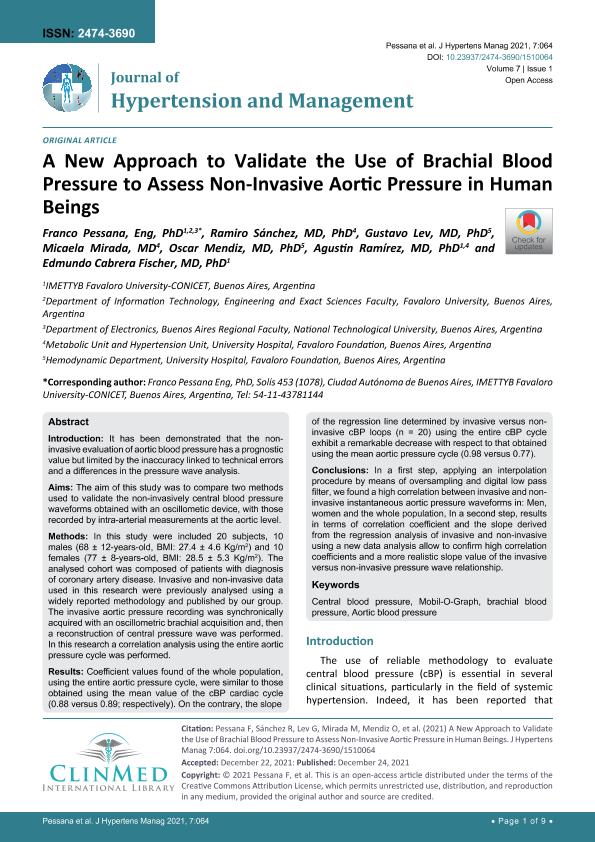Mostrar el registro sencillo del ítem
dc.contributor.author
Pessana, Franco Martin

dc.contributor.author
Sanchez, Ramiro
dc.contributor.author
Lev, Gustavo
dc.contributor.author
Mirada, Micaela
dc.contributor.author
Mendiz, Oscar
dc.contributor.author
Ramírez, Agustín José

dc.contributor.author
Cabrera Fischer, Edmundo Ignacio

dc.date.available
2023-09-15T11:06:49Z
dc.date.issued
2021-06
dc.identifier.citation
Pessana, Franco Martin; Sanchez, Ramiro; Lev, Gustavo; Mirada, Micaela; Mendiz, Oscar; et al.; A New Approach to Validate the Use of Brachial Blood Pressure to Assess Non-Invasive Aortic Pressure in Human Beings; ClinMed International Library; Journal of Hypertension and Management; 7; 1; 6-2021; 1-9
dc.identifier.issn
2474-3690
dc.identifier.uri
http://hdl.handle.net/11336/211583
dc.description.abstract
Introduction: It has been demonstrated that the noninvasive evaluation of aortic blood pressure has a prognostic value but limited by the inaccuracy linked to technical errors and a differences in the pressure wave analysis.Aims: The aim of this study was to compare two methods used to validate the non-invasively central blood pressure waveforms obtained with an oscillometic device, with those recorded by intra-arterial measurements at the aortic level.Methods: In this study were included 20 subjects, 10 males (68 ± 12-years-old, BMI: 27.4 ± 4.6 Kg/m2) and 10 females (77 ± 8-years-old, BMI: 28.5 ± 5.3 Kg/m2). The analysed cohort was composed of patients with diagnosis of coronary artery disease. Invasive and non-invasive dataused in this research were previously analysed using a widely reported methodology and published by our group.The invasive aortic pressure recording was synchronically acquired with an oscillometric brachial acquisition and, then a reconstruction of central pressure wave was performed.In this research a correlation analysis using the entire aortic pressure cycle was performed.Results: Coefficient values found of the whole population, using the entire aortic pressure cycle, were similar to those obtained using the mean value of the cBP cardiac cycle was analysed (0.88 versus 0.89; respectively). On the contrary, the slope of the regression line determined by invasiveversus non-invasive cBP loops (n = 20) using the entire cBP cycle exhibit a remarkable decrease with respect to that obtained using the mean aortic pressure cycle (0.98 versus 0.77).Conclusions: In a first step, applying an interpolation procedure by means of oversampling and digital low pass filter, we found a high correlation between invasive and noninvasive instantaneous aortic pressure waveforms in: Men, women and the whole population, In a second step, resultsin terms of correlation coefficient and the slope derived from the regression analysis of invasive and non-invasive using a new data analysis allow to confirm high correlation coefficients and a more realistic slope value of the invasive versus non-invasive pressure wave relationship.
dc.format
application/pdf
dc.language.iso
eng
dc.publisher
ClinMed International Library
dc.rights
info:eu-repo/semantics/openAccess
dc.rights.uri
https://creativecommons.org/licenses/by-nc-sa/2.5/ar/
dc.subject
CENTRAL BLOOD PRESSURE
dc.subject
MOBIL-O-GRAPH
dc.subject
BRACHIAL BLOOD PRESSURE
dc.subject
AORTIC BLOOD PRESSURE
dc.subject.classification
Otras Medicina Básica

dc.subject.classification
Medicina Básica

dc.subject.classification
CIENCIAS MÉDICAS Y DE LA SALUD

dc.title
A New Approach to Validate the Use of Brachial Blood Pressure to Assess Non-Invasive Aortic Pressure in Human Beings
dc.type
info:eu-repo/semantics/article
dc.type
info:ar-repo/semantics/artículo
dc.type
info:eu-repo/semantics/publishedVersion
dc.date.updated
2023-09-13T12:04:08Z
dc.journal.volume
7
dc.journal.number
1
dc.journal.pagination
1-9
dc.journal.pais
Estados Unidos

dc.journal.ciudad
Wilmington
dc.description.fil
Fil: Pessana, Franco Martin. Consejo Nacional de Investigaciones Científicas y Técnicas. Oficina de Coordinación Administrativa Houssay. Instituto de Medicina Traslacional, Trasplante y Bioingeniería. Fundación Favaloro. Instituto de Medicina Traslacional, Trasplante y Bioingeniería; Argentina
dc.description.fil
Fil: Sanchez, Ramiro. Fundación Favaloro; Argentina
dc.description.fil
Fil: Lev, Gustavo. Fundación Favaloro; Argentina
dc.description.fil
Fil: Mirada, Micaela. Fundación Favaloro; Argentina
dc.description.fil
Fil: Mendiz, Oscar. Fundación Favaloro; Argentina
dc.description.fil
Fil: Ramírez, Agustín José. Consejo Nacional de Investigaciones Científicas y Técnicas. Oficina de Coordinación Administrativa Houssay. Instituto de Medicina Traslacional, Trasplante y Bioingeniería. Fundación Favaloro. Instituto de Medicina Traslacional, Trasplante y Bioingeniería; Argentina
dc.description.fil
Fil: Cabrera Fischer, Edmundo Ignacio. Consejo Nacional de Investigaciones Científicas y Técnicas. Oficina de Coordinación Administrativa Houssay. Instituto de Medicina Traslacional, Trasplante y Bioingeniería. Fundación Favaloro. Instituto de Medicina Traslacional, Trasplante y Bioingeniería; Argentina
dc.journal.title
Journal of Hypertension and Management
dc.relation.alternativeid
info:eu-repo/semantics/altIdentifier/doi/http://dx.doi.org/10.23937/2474-3690/1510064
Archivos asociados
